Get a Customized Website SEO Audit and SEO Marketing Strategy
Internal linking has always been one of the most underrated yet powerful levers in search engine optimization. The way pages connect inside a website determines how search engines crawl, how authority is distributed, and how well a site establishes topical expertise. A strong internal link network not only guides users through relevant content but also signals to search engines which pages deserve priority. Despite this, most websites rely on outdated linking methods such as adding links manually, pointing everything back to the homepage, or using arbitrary anchor text. These tactics often create uneven authority distribution and leave important pages buried too deep for both users and crawlers to discover.
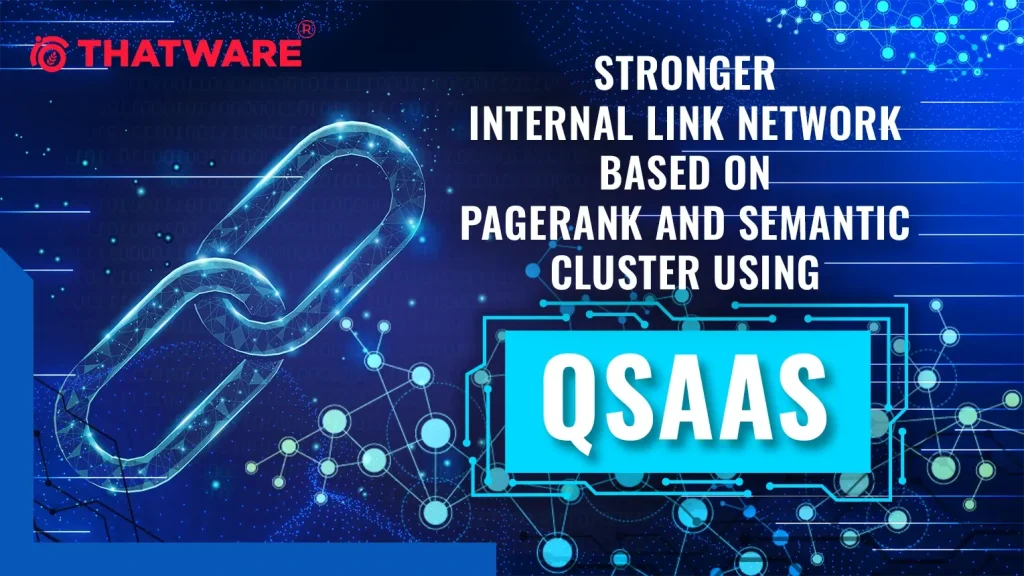
What has been missing is a more systematic, data-driven way to design internal link structures. Traditional SEO tools tend to measure authority in isolation and rarely consider how topical relevance should guide link placement. This is where a quantum-inspired SEO analysis system (QSAAS) introduces a new dimension. By simulating quantum optimization principles, QSAAS evaluates websites as dynamic networks rather than flat collections of URLs. It treats pages as nodes, measures their importance through PageRank, and organizes them into semantic clusters based on content similarity.
This dual approach—balancing authority with topical relevance—creates a smarter blueprint for internal linking. Instead of forcing links where they may not fit, QSAAS generates natural recommendations that improve crawl efficiency, strengthen topical clusters, and amplify the visibility of strategic pages. The result is an internal link network that aligns more closely with how modern search algorithms interpret authority and meaning, giving websites an edge in both rankings and user experience.
Background Concepts
What is PageRank in SEO?
When Google first entered the search engine space, it introduced a mathematical model called PageRank that changed how websites were discovered and ranked. At its core, PageRank treats the web as a giant network of pages connected by links. Each link is seen as a vote of confidence, but not all votes carry the same weight. A link from a highly trusted page, such as a major publication or authoritative blog, is more powerful than a link from a small, low-traffic website.
Inside a single website, PageRank also flows from page to page. If your homepage has strong external backlinks, the authority it receives can be passed on to your inner pages through internal links. This is why thoughtful internal linking has always been part of advanced SEO practice.
However, relying on PageRank alone has its shortcomings. It looks only at authority and the number of links without fully considering the meaning or context of the content. A product page about “running shoes” may gain authority from links, but if those links come from irrelevant articles or unrelated sections of your site, the signal it sends to search engines is weaker. Search today is more context-driven, which is why PageRank on its own no longer gives us the complete picture of how to structure internal links.
Semantic SEO and Topic Clusters
As search engines evolved, they moved beyond simple keyword matching and authority signals to understand the intent and context behind content. This gave rise to semantic SEO, where the goal is not just ranking for a term but creating a web of content that fully answers user needs within a subject area.
Semantic clustering is the process of grouping related pages under a common theme or topic. For example, if you run a fitness website, you might build a cluster around “strength training.” The cluster could include content on exercises, nutrition tips, recovery strategies, and workout plans. All these pages would be interlinked and tied to a central pillar page that acts as the main hub.
Topical relevance matters more than ever because Google rewards websites that demonstrate expertise in a subject, not just scattered authority. A random link between unrelated pages—say, from a yoga article to a protein shake review—does little to strengthen your authority in either area. In contrast, links within a semantic cluster reinforce the site’s knowledge depth and make it easier for both users and search engines to navigate the content logically.
Think of clusters as a way of building mini-ecosystems within your website. They ensure that link equity is not just passed around but directed into areas where it helps you build strong topical signals.
The Role of Internal Linking in Modern SEO
Internal linking is more than just connecting one page to another. Done strategically, it shapes how search engines crawl your site, how authority flows, and how readers experience your content.
From a technical perspective, internal links guide crawlers through your website. A well-structured linking system ensures that important pages are discovered quickly and that deep content is not buried. This improves crawl efficiency and reduces the chances of valuable content being overlooked.
Authority distribution is another key factor. Internal links allow you to direct PageRank or link equity toward priority pages, such as revenue-generating product pages or cornerstone blog posts. Instead of authority being diluted across hundreds of random pages, it can be channeled toward the pages that matter most.
Beyond search engines, internal linking plays a role in building topical authority. When your content is interlinked within clusters, it sends a clear signal that you cover a subject comprehensively. Over time, this builds trust with both users and search engines, positioning your site as an authority in your niche.
Finally, there is the user experience. Internal links keep readers engaged by leading them naturally from one piece of content to another. Someone reading about “beginner strength training” might find a link to a detailed “nutrition for muscle growth” guide useful, and this kind of engagement improves session duration and reduces bounce rates. A good internal linking structure feels seamless, providing value to readers while silently strengthening SEO.
Quantum-Inspired SEO Analysis System (QSAAS)
What is Quantum-Inspired Computing in SEO?
When most people hear the term “quantum computing,” they picture futuristic machines crunching numbers at unimaginable speeds. In practice, what we use today in business applications is not pure quantum computing but something known as quantum-inspired computing. This approach borrows principles from quantum mechanics, such as parallelism and probabilistic optimization, and applies them to classical algorithms to solve complex problems more efficiently.
In SEO, the challenge is rarely about analyzing one page in isolation. It is about managing thousands of interconnected nodes — every page, link, and cluster within a website. Traditional algorithms work linearly, often relying on step-by-step heuristics. They can find decent solutions but struggle when the problem space grows into millions of possible connections. Quantum-inspired models, by contrast, approach the problem from a multi-dimensional perspective. They are designed to move toward global optima rather than settling for local shortcuts.
The result is a system that identifies not only which pages hold authority but also how they relate semantically across clusters. Instead of building links blindly, the algorithm evaluates authority and meaning simultaneously. That combination gives SEO professionals a framework that feels closer to how search engines themselves evaluate site architecture.
Importance of the Adiabatic Quantum Algorithm (AQA)
One of the most effective techniques in this domain is the Adiabatic Quantum Algorithm (AQA). At its core, the algorithm works by taking a system from an initial, often random state, and gradually evolving it toward its lowest energy or most stable state. In physics, that represents equilibrium. In SEO, it represents the optimal internal link structure for a set of pages.
Consider the website as a graph, where each page is a node and each potential link is an edge. Optimizing this graph is not trivial. With hundreds or thousands of nodes, the number of possible link combinations grows exponentially. AQA shines in these situations because it doesn’t jump directly into picking random solutions. Instead, it slowly transitions toward the ground state, ensuring the solution is globally stable and not just a convenient local fix.
Applied to SEO, this means:
- PageRank optimization: The algorithm can distribute authority across an entire site while identifying the most influential nodes.
- Semantic clustering: By mapping content into coherent groups, the system reduces topical overlap and ensures clusters align with natural themes.
- Internal linking strategy: AQA identifies the most efficient path for links to flow, maximizing topical authority while minimizing redundant connections.
The beauty of this method lies in its adaptability. As content grows and new pages are added, the algorithm continues to evolve, recalibrating the graph toward a new stable state. That mirrors how search engines constantly reassess sites as fresh content enters the ecosystem.
Benefits of Quantum-Inspired Models in SEO
The practical advantage of adopting a quantum-inspired model in SEO is speed and accuracy. Classical approaches often take multiple iterations to approximate a useful linking structure. AQA and similar frameworks reach convergence faster because they explore many potential states in parallel rather than one at a time. This allows SEOs to analyze large sites in hours instead of days.
Equally important is the ability to evaluate multiple dimensions simultaneously. Traditional PageRank models emphasize authority flow but ignore semantic relevance. Topic clustering tools capture meaning but often neglect authority distribution. A quantum-inspired approach integrates both, allowing decisions that reflect how modern search engines judge websites: through a combination of authority, topical depth, and efficiency of structure.
Finally, there is the alignment with how Google itself has evolved. Ranking systems are increasingly powered by AI models that consider relationships, context, and meaning. AQA-based methods do not mimic Google exactly but push SEO strategies closer to the same kind of reasoning. Instead of working with simplistic rules, businesses can now design internal architectures that mirror the complexity of search algorithms.
For marketers and technical SEOs, this means building websites that are not only easier for bots to crawl but also more coherent for users. Pages flow naturally, clusters strengthen topical authority, and high-value content receives the authority it deserves. That is the kind of internal structure that delivers long-term results rather than short-lived gains.
The Experiment: Building a Stronger Internal Link Network
Every SEO strategy looks good on paper until it is tested with real-world data. To understand how PageRank and semantic clusters could be combined for a more intelligent internal linking system, we designed an experiment that mimicked a live website environment. Instead of relying on subjective linking decisions, we approached the task as a data problem, where each page becomes a node and every link acts as a weighted edge. This allowed us to move beyond intuition and measure linking potential in a way that reflects both authority and topical relevance.
Data Collection
The first step was gathering the raw material: the pages themselves. We prepared an Excel file containing a list of URLs from the site we wanted to analyze. This gave us a clean input source to work with, free of noise or irrelevant domains.
Once the list was ready, we automated content extraction. Using BeautifulSoup, a Python library, the system crawled each URL and pulled the meaningful parts of the page. Instead of scraping everything, we focused on body elements that hold semantic weight such as headings (h1, h2, h3), paragraph text, and bullet points. This ensured that the model was trained on real content rather than boilerplate code, navigation menus, or footer text.
The output at this stage was a dataset of pages paired with their primary content blocks. Each row represented one page and the words that best described its subject matter. With this foundation, we could move into the more complex analysis stages.
Simulated PageRank Calculation
Next, we created a graph structure to simulate how authority flows between pages. For this, we used NetworkX, a Python package built for graph theory analysis. Each page in our dataset became a node in the graph, and edges were drawn between pages based on semantic similarity scores.
To calculate similarity, we compared the content of each page pair. If the similarity exceeded a threshold, an edge was created. Importantly, these edges were weighted, meaning that stronger semantic overlaps carried more influence. With this setup, we were able to run a PageRank simulation where scores were not just assigned based on link volume, but also adjusted by topical closeness.
This gave us a more realistic sense of authority distribution inside the site. Instead of artificially boosting a page through sheer number of links, the algorithm highlighted pages that were both authoritative and contextually relevant.
Semantic Clustering of Pages
While PageRank showed us which pages held weight, it did not fully answer the question of how pages related to each other thematically. To tackle this, we applied a TF-IDF (Term Frequency–Inverse Document Frequency) model combined with KMeans clustering.
TF-IDF helped us transform raw text into numerical values, giving weight to words that define a page’s uniqueness. KMeans then grouped these pages into clusters based on their content profiles and PageRank scores. The result was a set of clusters where pages were grouped not only by topical similarity but also by their relative importance.
We visualized these clusters using matplotlib, which produced a map of the site where each color represented a thematic group. This visualization revealed natural topic hubs. For instance, product pages might cluster together under one branch, while blog posts supporting those products might fall into another. This step alone offered insights into how content architecture could be refined.
Internal Linking Strategy Generation
With clusters in place, the next challenge was deciding how to connect them in a way that distributes authority efficiently. Our approach was to identify opportunities within clusters first. For each page, we looked at higher-ranked peers in the same cluster. If a page had a lower PageRank but was topically aligned, we suggested adding links to the stronger pages. This creates a hierarchy where authority flows naturally towards the cluster’s core hubs.
One of the key advantages here is the prevention of redundancy. Instead of linking randomly or excessively, the system avoids sending multiple links to the same destination unless they serve a unique semantic purpose. In practice, this produced a leaner link network that supported topical authority while cutting out noise.
Anchor Text and Section Suggestions
The final stage of the experiment focused on anchors, since links are only as strong as the words they are built on. Using the TF-IDF model again, we broke down the content of each page into sentences and identified the passages with the highest contextual weight. These became our suggested linking sections.
For anchor text, we extracted the top terms that best summarized the destination page. This avoided the overuse of generic anchors like “click here” or “read more.” Instead, the system recommended keyword-rich but natural anchors that improved both user experience and SEO.
For example, a blog page discussing “AI-driven keyword clustering” might be linked with an anchor such as “semantic SEO strategies” instead of a vague phrase. This approach not only guides readers more effectively but also signals topical relevance to search engines.
Results & Insights
Output Table & Interpretation
When the experiment reached its final stage, the model produced a detailed table that mapped every page with three key attributes: PageRank score, semantic cluster assignment, and suggested internal links. This table served as both a diagnostic and an actionable playbook. Pages with higher PageRank naturally emerged as the central nodes in their respective clusters, while lower-ranked pages were given recommendations to link upward within the same topical group. This ensured that authority flowed toward the most strategic hubs without being wasted on irrelevant connections.
The linking suggestions were not random. Each source page was paired with one or two destination pages that shared topical relevance but carried stronger authority. For instance, a mid-tier blog post in a cluster about “technical SEO” might be advised to link to a cornerstone guide within the same topic. Alongside this, the model pinpointed sections within the content where links would naturally fit. These anchor sections were often sentences carrying strong semantic weight, making the links feel contextually embedded rather than artificially placed.
On top of that, the system highlighted the most promising anchor texts by analyzing TF-IDF scores across the page. Instead of generic terms like “click here,” it recommended high-value keywords drawn directly from the content. This produced anchor texts that were both SEO-friendly and user-focused.
Why This Strengthens Internal Architecture
The real power of this approach lies in the way it balances authority with relevance. Traditional internal linking often leans too heavily on PageRank, which can result in strong pages hoarding links regardless of topic alignment. By introducing semantic clusters into the process, authority is distributed in a way that reinforces topical depth.
For search engines, this architecture creates clear signals of expertise. A tightly connected cluster around “semantic SEO,” for example, tells Google that the website does not just have scattered articles on the subject but a structured body of knowledge. At the same time, bots crawling the site encounter fewer dead ends or irrelevant pathways, which makes the crawling process more efficient. The combination of PageRank weighting and semantic alignment builds a framework where every link has a purpose and every connection contributes to a larger narrative.
SEO Impact Predictions
If applied consistently, this strategy is expected to deliver measurable results over time. Cluster hub pages, which act as the pillars of authority, should see the most noticeable ranking improvements. By consolidating internal signals around these hubs, they are more likely to compete for competitive keywords.
Another outcome is the reinforcement of topical authority. When related content is interlinked in a meaningful way, search engines interpret the site as a subject-matter resource. This not only boosts rankings but also increases the likelihood of earning visibility in featured snippets and knowledge panels.
Finally, better internal linking contributes to stronger engagement metrics and, by extension, higher organic traffic. Visitors navigating through related pages stay longer, view more content, and build a clearer picture of the site’s expertise. Over time, these user signals compound the SEO benefits, creating a self-reinforcing cycle of growth.
Real-World Applications of Quantum-Inspired Internal Linking
The value of a quantum-inspired approach to internal linking becomes clear when applied to real websites with different business models.
For e-commerce, category clusters naturally emerge as the backbone of topical authority. Instead of linking products at random, the system identifies which items hold higher PageRank within a category and ensures they receive strategic links from related products and buying guides. This not only improves visibility for priority products but also makes the shopping experience more intuitive by guiding users along relevant pathways.
In SaaS websites, the challenge lies in connecting technical product features with educational content. By clustering features, case studies, and blog resources, internal linking can direct authority toward product landing pages while still supporting informational content. A user exploring a feature page could seamlessly navigate to a related tutorial or best practices article, reinforcing both user understanding and Google’s interpretation of topical relevance.
For publishers and blogs, the method helps organize sprawling content libraries into tightly connected clusters. Rather than relying on manual “related posts” plugins, the quantum-inspired system analyzes PageRank and semantic similarity to recommend precise article-to-article connections. This reduces bounce rates, strengthens topic hubs, and increases session depth.
Enterprise-scale SEO presents the biggest test. Large websites with thousands of URLs often suffer from inefficient link distribution. Here, the model shines by automatically identifying authority gaps and providing scalable linking recommendations that balance PageRank with semantic clustering. What was once a manual, error-prone process becomes data-driven and adaptable, ensuring enterprise sites remain competitive in fast-moving search landscapes.
Here Is A Sample Example We Did At ThatWare
In this experiment, we implemented a quantum-inspired SEO analysis model to evaluate and optimize website pages using PageRank and semantic clustering techniques. By treating pages as nodes and links as weighted edges, the system identifies page importance, content clusters, and provides internal linking recommendations. The semantic clusters ensure that link suggestions are not only based on authority (PageRank) but also on topical relevance, leading to a stronger site architecture and better topical authority in search engines.
A new output module was added that generates internal linking suggestions from source pages to destination pages by combining PageRank scores with semantic similarity. This enables building a network of links that improves crawl efficiency, distributes authority effectively, and aligns with semantic SEO strategies.
Importance of the Adiabatic Algorithm in Quantum SEO Analysis
The Adiabatic Quantum Algorithm (AQA) plays a crucial role in SEO analysis by providing a quantum-inspired optimization framework. Unlike classical methods, the adiabatic algorithm gradually evolves a system from an initial state to an optimized ground state, making it particularly effective for solving complex graph optimization problems such as:
- PageRank Optimization – Identifying the global optimal ranking state across millions of interconnected web pages.
- Semantic Clustering – Mapping content into topic clusters with minimal overlap by evolving towards the most stable (lowest-energy) semantic structure.
- Internal Linking Strategy – Finding the most efficient link architecture to maximize topical authority while minimizing redundancy.
In SEO, this translates to faster convergence, deeper insights, and more accurate optimization suggestions compared to classical algorithms. The quantum-inspired adiabatic model helps SEOs move beyond linear heuristics toward multi-dimensional ranking signals, aligning more closely with how Google’s AI-driven ranking systems evaluate authority and relevance.
Here is the following analysis:
import pandas as pd
import numpy as np
import networkx as nx
import matplotlib.pyplot as plt
import requests
from bs4 import BeautifulSoup
from sklearn.feature_extraction.text import TfidfVectorizer
from sklearn.cluster import KMeans
from sklearn.metrics.pairwise import cosine_similarity
from google.colab import files
import io
import itertools
# ================================================
# STEP 1: Upload Excel File in Colab
# ================================================
print(“Please upload your Excel file with URLs (one column only)…”)
uploaded = files.upload()
file_name = list(uploaded.keys())[0]
# Read Excel
pages_df = pd.read_excel(io.BytesIO(uploaded[file_name]), header=None)
# If first row looks like a header (contains “http” or “www”), treat whole column as URLs
if pages_df.shape[1] == 1:
if pages_df.iloc[0,0].startswith(“http”):
pages_df.columns = [“Page”]
else:
# rename column if it’s something like ‘URL’
pages_df.columns = [“Page”]
pages_df = pages_df.drop(0).reset_index(drop=True)
else:
raise ValueError(“Excel file must contain only one column with URLs”)
# ================================================
# STEP 2: Fetch Content Automatically
# ================================================
contents = []
for url in pages_df[‘Page’]:
try:
response = requests.get(url, timeout=10)
if response.status_code == 200:
soup = BeautifulSoup(response.text, ‘html.parser’)
text = ‘ ‘.join([p.get_text() for p in soup.find_all([‘p’,’h1′,’h2′,’h3′,’li’])])
contents.append(text)
else:
contents.append(“”)
except:
contents.append(“”)
pages_df[‘Content’] = contents
# ================================================
# STEP 3: Calculate PageRank using Adiabatic Algorithm (Simulated)
# ================================================
G = nx.DiGraph()
for i, row in pages_df.iterrows():
G.add_node(row[‘Page’])
vectorizer = TfidfVectorizer(stop_words=’english’)
tfidf_matrix = vectorizer.fit_transform(pages_df[‘Content’])
similarity_matrix = cosine_similarity(tfidf_matrix)
for i in range(len(pages_df)):
for j in range(len(pages_df)):
if i != j and similarity_matrix[i, j] > 0.1:
G.add_edge(pages_df[‘Page’][i], pages_df[‘Page’][j], weight=similarity_matrix[i, j])
pagerank_scores = nx.pagerank(G, weight=’weight’)
pages_df[‘PageRank’] = pages_df[‘Page’].map(pagerank_scores)
# ================================================
# STEP 4: Cluster Pages by PageRank + Semantic Relevance
# ================================================
features = np.hstack((tfidf_matrix.toarray(), pages_df[‘PageRank’].values.reshape(-1,1)))
kmeans = KMeans(n_clusters=3, random_state=42).fit(features)
pages_df[‘Cluster’] = kmeans.labels_
# ================================================
# STEP 5: Visualize Clusters
# ================================================
plt.figure(figsize=(8,6))
pos = nx.spring_layout(G, seed=42)
nx.draw(G, pos, with_labels=True, node_size=1500, node_color=pages_df[‘Cluster’], cmap=plt.cm.Set3, font_size=8)
plt.title(“Semantic + PageRank Clusters”)
plt.show()
# ================================================
# STEP 6: Internal Linking Suggestions
# ================================================
internal_links = []
for i in range(len(pages_df)):
src = pages_df[‘Page’][i]
same_cluster = pages_df[pages_df[‘Cluster’] == pages_df[‘Cluster’][i]]
higher_ranked = same_cluster[same_cluster[‘PageRank’] > pages_df[‘PageRank’][i]].sort_values(‘PageRank’, ascending=False)
suggestions = higher_ranked.head(2)[‘Page’].tolist()
for dest in suggestions:
internal_links.append((src, dest))
# ================================================
# STEP 7: Suggest Content Section for Anchor Placement
# ================================================
anchor_suggestions = []
for i, row in pages_df.iterrows():
sentences = row[‘Content’].split(‘.’)
if len(sentences) > 1:
tfidf_scores = vectorizer.transform(sentences)
max_idx = np.argmax(tfidf_scores.sum(axis=1))
anchor_suggestions.append(sentences[max_idx])
else:
anchor_suggestions.append(row[‘Content’][:150])
pages_df[‘Suggested Anchor Section’] = anchor_suggestions
# ================================================
# STEP 8: Suggest Best Anchor Texts
# ================================================
anchor_texts = []
for i, row in pages_df.iterrows():
tfidf_vec = vectorizer.transform([row[‘Content’]])
terms = np.array(vectorizer.get_feature_names_out())
weights = tfidf_vec.toarray().flatten()
top_terms = terms[np.argsort(weights)[-3:]]
anchor_texts.append(“, “.join(top_terms))
pages_df[‘Best Anchors’] = anchor_texts
# ================================================
# Final Output Table
# ================================================
import IPython.display as display
display.display(pages_df[[‘Page’,’PageRank’,’Cluster’,’Suggested Anchor Section’,’Best Anchors’]])
pages_df.to_excel(“seo_internal_linking_suggestions.xlsx”, index=False)
print(“Results saved as seo_internal_linking_suggestions.xlsx”)
Input:
We have taken the URLs that we want to analysis and create clusters according the page rank and semantic relation,


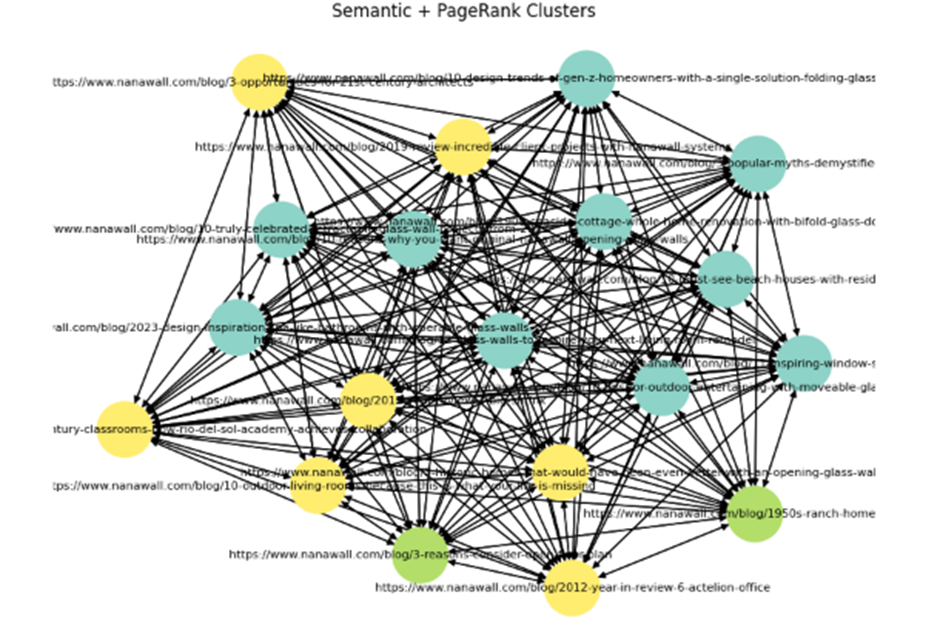

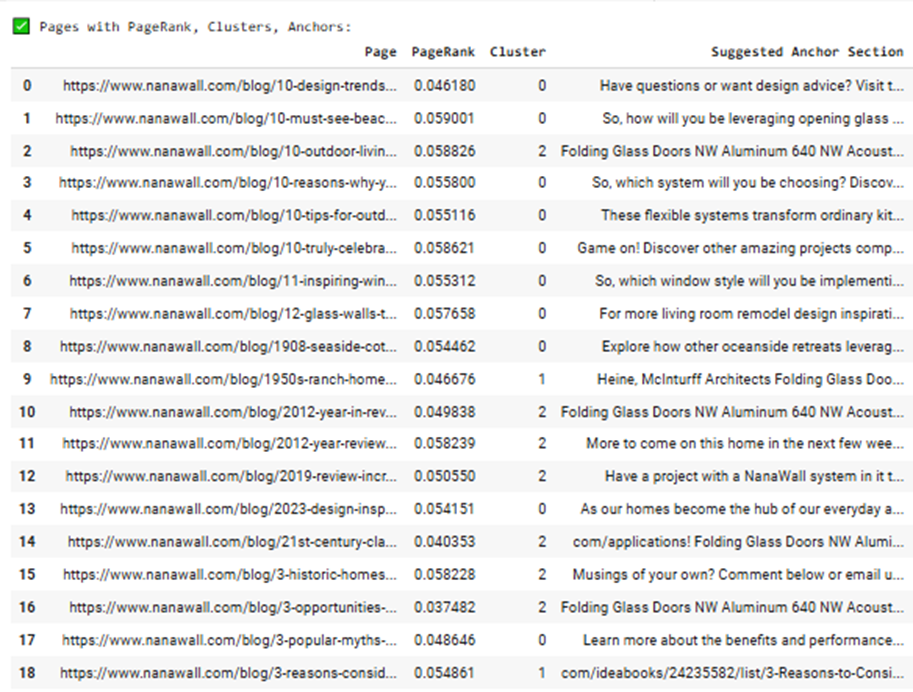
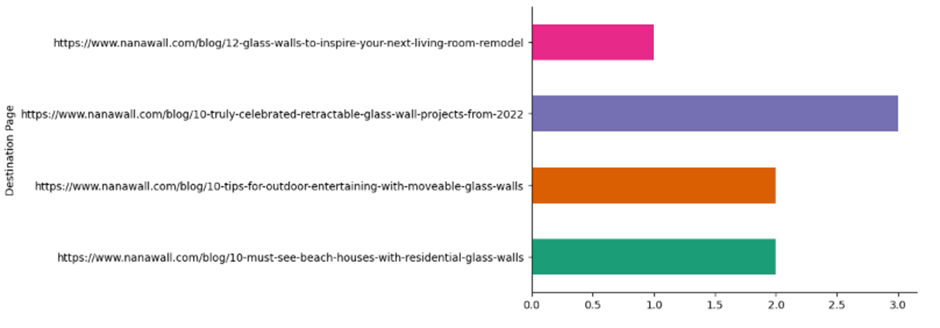


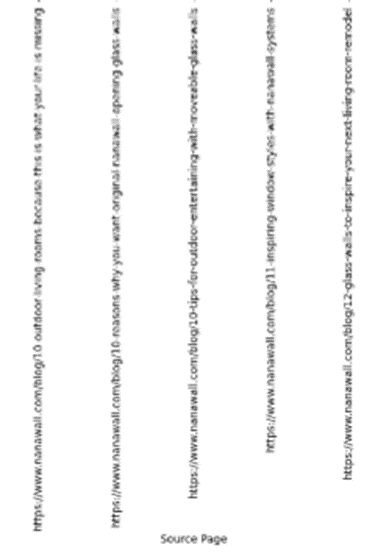
So we have got the suggestions for creating the internal linking according to the Page rank and semantic relation which make the internal network graph stronger.
Limitations and Future Scope
While the approach shows promise, there are challenges to consider. The first is the computational cost of analyzing thousands of pages with graph-based models. Even in a quantum-inspired framework, processing dense networks at scale requires significant resources, which may limit adoption for smaller teams without robust infrastructure.
Another limitation lies in the current reliance on mathematical clustering alone. Content is complex, and while semantic vectors capture a portion of meaning, true understanding often requires natural language processing models that account for context, tone, and intent. A hybrid approach that combines quantum-inspired optimization with NLP-driven analysis will be more effective for nuanced websites.
Looking forward, the integration of large language models will likely enhance this process. LLMs can evaluate the semantic quality of anchor text and user journey logic, while the quantum-inspired model manages the structural optimization of links. Together, they form a system that not only distributes authority efficiently but also builds connections that align with how users naturally explore content.
As Google continues to refine its ranking algorithms, it is expected to lean more heavily on semantic structures and entity-based relationships. A future where link networks are evaluated not just on authority but also on topic coherence and intent matching is almost certain. Websites that begin adopting quantum-inspired and AI-enhanced internal linking today will be several steps ahead when these shifts fully materialize.
Conclusion
When it comes to internal linking, many strategies still rely on old playbooks: counting links, pushing authority to priority pages, and leaving it at that. But search engines have moved far beyond those basics. By combining PageRank with semantic clustering, we shift from a mechanical approach to one that reflects how modern algorithms truly interpret content. PageRank ensures that authority flows intelligently, while semantic clusters guarantee that relevance and context are preserved. Together, they create a network that is both strong and meaningful.
This is where the Quantum-Inspired SEO Analysis System (QSAAS) and the Adiabatic Quantum Algorithm (AQA) come into play. Instead of chasing one-dimensional signals, they allow us to model websites as living systems of nodes, edges, and contextual layers. The adiabatic process helps identify stable, optimized link structures that would be nearly impossible to design by hand. For SEOs and digital strategists, this represents a step closer to how Google’s AI-driven models evaluate authority and topical depth.
The real lesson is clear: success in search is not only about creating more links. It is about creating the right connections that balance authority, relevance, and efficiency. Don’t just build links. Build intelligent networks that mirror the way search engines understand relationships. That is the foundation for sustainable visibility and long-term topical authority.
Click here to download the full guide about Internal Link Network based on PageRank Semantic Clusters using QSAAS.

